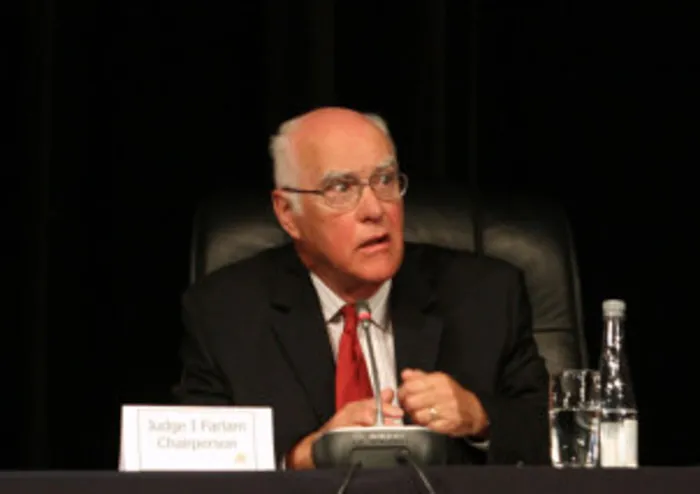Marikana scenes mapped out

From left: advocate Pingla Hemraj, Marikana commission chairman Ian Farlam and advocate Bantubonke Tokota are seen during the first week of the inquiry at the Civic Centre in Rustenburg in the North West, Wednesday, 3 October 2012. The judicial commission of inquiry into the shooting at Lonmin platinum mine was postponed on Wednesday. Lawyers representing the different parties unanimously decided to postpone the matter to 9am on October 22. Thirty-four miners were killed and 78 wounded when police opened fire on them while trying to disperse protesters near the mine in Marikana on August 16. Picture: SAPA stringer From left: advocate Pingla Hemraj, Marikana commission chairman Ian Farlam and advocate Bantubonke Tokota are seen during the first week of the inquiry at the Civic Centre in Rustenburg in the North West, Wednesday, 3 October 2012. The judicial commission of inquiry into the shooting at Lonmin platinum mine was postponed on Wednesday. Lawyers representing the different parties unanimously decided to postpone the matter to 9am on October 22. Thirty-four miners were killed and 78 wounded when police opened fire on them while trying to disperse protesters near the mine in Marikana on August 16. Picture: SAPA stringer
Rustenburg - A map of events in Marikana between August 12 and 16 was shown on Tuesday to the Farlam Commission into the shooting of Lonmin platinum mine workers.
Crime scene technician Lt-Col Cornelius Johannes Botha pointed out 12 crime scenes - marked A to L on a Google map.
The scenes included areas where two security guards were killed, where police officers were killed, and four areas where “civilian” bodies were found.
It also showed the hill in Wonderkop where miners gathered, called scene one; and a kraal and a small hill, called scene two.
The commission, chaired by retired judge Ian Farlam, is tasked with establishing the cause of police opening fire on a group of striking miners encamped on a hill in Nkaneng, killing 34 and wounding 78 on August 16.
The workers had been carrying knobkerries, pangas, sticks and iron rods.
Workers at the mine went on strike on August 10, demanding a monthly salary of R12 500. Within four days, 10 people had been killed, among them two policemen and two security guards.
Botha also showed an aerial photo of the area on August 13 - when two policemen and three mineworkers were killed in clashes - showing the crime scenes to which he attended.
He pointed out on the photo the locations where he had found bodies, spent cartridges and other objects.
In one area, Botha said he found 10 9mm cartridge cases, two rubber bullets from a shotgun and three shotgun cartridge cases.
There were also two small pools of blood close to each other, said Botha.
In a second area, he found a shotgun cartridge case, a piece of folded paper with possibly dagga inside, a ballistic round, a shotgun cartridge, two R5 cartridge cases and a shoe.
At a third scene, shown on the photo, Botha said he found eight shotgun cartridges, two R5 cartridge cases, four gas rubbers, and a stun grenade handle.
Two knobkerries, a woollen cap, a piece of sharpened iron and a blanket were also found.
Evidence leader Mbuyiseli Madlanga, who was leading Botha's evidence, asked him if his team had made its best attempt in putting the information together for the commission.
Botha said the evidence team had told him how he should put the photos together.
Farlam asked Botha if he had thoroughly searched the scene.
Botha said he had, but that “you have to draw a line somewhere, you can't search all the way to Marikana”.
Advocates for the various parties were given a chance to cross-examine Botha's evidence. - Sapa